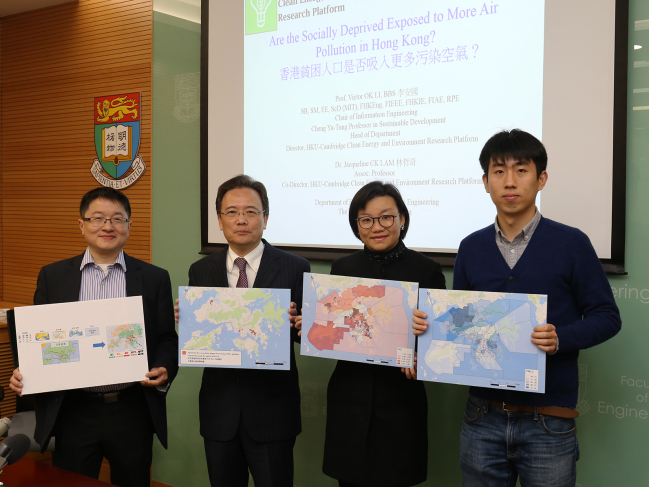Media
Are the Socially Deprived Exposed to More Air Pollution in Hong Kong?
HKU-Cambridge CEERP reveals air pollution-induced environmental injustice
29 Jan 2018

(From left) HKU Faculty of Engineering Assistant Dean (External Relations and Knowledge Exchange) Dr Wilton Fok Wai-tung, HKU-Cambridge Clean Energy and Environment Research Platform (CEERP) Director Professor Victor Li On-kwok, HKU-Cambridge Clean Energy and Environment Research Platform (CEERP) Co-Director Dr Jacqueline Lam Chi-kei, and HKU Faculty of Engineering PhD student Mr Yang Han introduce their research on air pollution-induced environmental injustice.
Poor air quality can result in extremely detrimental health consequences, such as cancer, stroke, asthma or heart disease [1, 2]. Interdisciplinary research conducted by the HKU-Cambridge Clean Energy and Environment Research Platform (HKU-Cambridge CEERP) revealed that there is a statistically significant, positive relationship between ambient PM2.5 (Particulate Matter of width 2.5 microns or less) concentration and the Social Deprivation Index in Hong Kong, and showed the existence of air pollution-induced environmental injustice at the constituency area level in the territory. The paper was recently published in the journal Environmental Science and Policy (Li, V.O.K., Han, Y., Lam, J.C.K., Zhu, Y., and Bacon-Shone, J., 2018, Air pollution and environmental injustice: Are the socially deprived exposed to more PM2.5 pollution in Hong Kong?, 80, 2018, 53-61).
The starting point for the research was: Are the socially deprived exposed to a higher level of air pollution in Hong Kong? Can this exposure to air pollution therefore be seen as environmental injustice? Existing research on air pollution-induced environmental injustice in Hong Kong was based on sparse air pollution data due to the limited number of government pollution monitoring stations (only 16, one added recently) in the territory, rendering it difficult to study the relationship between air pollution exposure and social deprivation (SD), and hence the study of environmental injustice, at finer geographical scales.
This challenge was recently overcome by a breakthrough research led by Professor Victor Li On-kwok, Director of HKU-Cambridge CEERP and Head of Department of Electrical and Electronic Engineering (EEE), Faculty of Engineering, HKU and Dr Jacqueline Lam Chi-kei, Co-Director of CEERP and Associate Professor at the HKU Department of EEE, through the development of a Granger Causality Model. This model utilised readily available urban dynamics data closely related with air pollution as proxy data, including ambient pollutants concentration, traffic, meteorology and urban morphology to provide a fine-grained (100m × 100m) estimation of air pollution in Hong Kong, transforming the measurements of 16 government monitoring stations to 110,000 virtual stations. Ambient pollutants concentrations are available from Hong Kong Environmental Protection Department, vehicular traffic data from Hong Kong Transport Department, meteorology data from Hong Kong Observatory, and urban morphology data including urban layout and roadmap from Baidu Map. The fine-grained estimation allows us to identify the areas with the highest level of pollutants concentration, thus providing important inputs for policy-making.
Our investigation focuses on whether there was any differential distribution in PM2.5 pollution across the 412 constituency areas with different levels of SD. Our study focuses specifically on the ambient PM2.5 concentration, given its serious health consequences and the potential differential PM2.5 distribution across groups of different socio-economic status (SES) in Hong Kong.
SD is measured by the Social Deprivation Index (SDI), which is a composite indicator comprising four SES variables, namely, low-income, low-education, non-professional occupation, and non-owner occupier, selected and combined via Principal Component Analysis. SES data are available from the 2011 Population Census.
The team found that there is a statistically significant, positive relationship between ambient PM2.5 concentration and SDI in Hong Kong, based on the SDI and mean PM2.5 exposure values derived from 412 constituency areas. The higher the SDI, the higher the mean PM2.5 exposure. In other words, the postulation of air pollution-induced environmental injustice at the constituency area level in Hong Kong is justified.
This study highlights an emerging need for Hong Kong to develop more integrated, human-centric, location- and justice-based environmental policies, and the need for evidence-based policy-decision-making to properly address air pollution-induced environmental injustice.
The policy implications and recommendations can be extended to the rest of the world, particularly cities like Beijing, where the growth of Gross Domestic Product is rapid, population density and pollution concentrations (including particulate pollution) are high, and the income gap between the rich and the poor is widening.
The journal paper can be viewed and downloaded here:
https://www.sciencedirect.com/science/article/pii/S1462901117306020
Media enquiries:
Professor Victor Li On-kwok, Director, HKU-CEERP (Tel: +852 2857 8425; Email: vli@eee.hku.hk)
Dr Jacqueline Lam Chi-kei, Co-Director, HKU-CEERP (jcklam@eee.hku.hk)
Ms Rhea Leung, Communication and Public Affairs Office (Tel: +852 2857 8555/ +852 9022 7446; Email: rhea.leung@hku.hk)
Ms Bonnie Tsang, Faculty of Engineering (Tel: +852 3917 1924; Email: bonniepy@hku.hk)
[1] Pope III, C.A., Dockery, D.W., 2006. Health effects of fine particulate air pollution: lines that connect. J. Air Waste Manage. Assoc. 56, 709–742.
[2] Pui, D.Y., Chen, S.-C., Zuo, Z., 2014. PM 2.5 in China: measurements, sources, visibility and health effects and mitigation. Particuology 13, 1–126.



